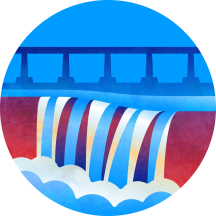It's one of Geneva's most recognisable landmarks.
This giant water spout is the Jet d’eau.
The water from it spouts up hundred and forty metres (460 feet), throwing up 500 litres of water per second.
And its droplets rain down on Lake Geneva, soaking tourist boats and birds alike.
This morning Frederic Schulz has arrived at an underground facility on the lake to make sure everything is in working order before the jet is switched on.
“The Jet d’eau functions thanks to two 500 kw water pumps. They suck water from the lake and jet it upwards at a speed of 200 kilometres per hour, 140 metres high. There are always 7 tons of water up in the air. It pumps 500 litres per second,” he explains.
At 9am, the nozzle opens, a button in a secret location is pressed, and the water feature bursts into life.
The skyline of Geneva is finally complete.
The world-famous landmark didn’t come as a result of a planned publicity stunt but rather as a solution to an engineering problem.
In the mid 1880s, the city’s economy was booming, and had almost doubled its population to 100,000 people.
More people and industry meant more energy was needed, and a hydraulic plant was built at the mouth of the River Rhone.
In order to release the excess pressure built up by the plant, a safety valve was installed to control the pressure.
At the time, the water jet reached 30 metres (98 feet) high and only erupted at night.
Eventually, an innovative mechanism meant it was no longer necessary to release water to stop the build-up of pressure.
But by that time, Genevans had grown fond of their makeshift water fountain.
To keep everybody happy, the local authorities decided to build a second Jet d’eau, but at a more central and panoramic location, where it stands today.
At the height of the summer season, tourists flock to this pier to get a closer view of the giant.
Dutch visitor Corean Doombos says she saw something special in the mist.
“It’s very high. It’s beautiful. I think when the rain comes down you can see a rainbow maybe in it. And the city is beautiful. I think it’s part of the city,” she says.
Marjorie de Chastonay is the administrative council of Geneva.
She says that besides being a visual landmark, the Jet d’eau also has deeper meaning.
“The Jet d’eau isn’t just an important monument that is also a symbol of Geneva. But it’s also a symbol of the international Geneva," she says.
"For instance, recently the Jet d’eau has been illuminated with the colours of the Swiss flag because of the country’s national day August 1. And also for the 80th anniversary of the bombing of Hiroshima August 6.”
The Jet d’eau was officially inaugurated in 1891. It was initially only operational on Sundays and public holidays, drawing water from the city’s drinking water system.
It grew so popular that from 1906, it was turned on on some weekdays.
In 1951 the water spout was modernized with a stronger system, reaching its current height of 140 metres, but this time drawing water from the lake itself.
AP video shot by: Hernan Munoz

 Associated Press US and World News Video
Associated Press US and World News Video
 America News
America News Democrat and Chronicle
Democrat and Chronicle The Washington Post
The Washington Post Bonner County Daily Bee Lifestyle
Bonner County Daily Bee Lifestyle The Advocate
The Advocate Daily Freeman
Daily Freeman FOX 32 Chicago Lifestyle
FOX 32 Chicago Lifestyle The Shaw Local News Sports
The Shaw Local News Sports The Des Moines Register
The Des Moines Register Essentiallysports College Sports
Essentiallysports College Sports CBS News
CBS News